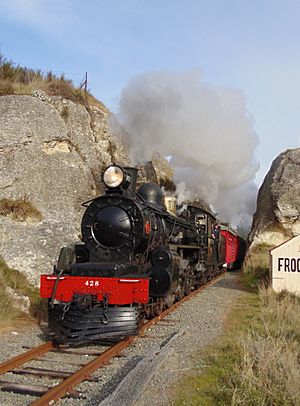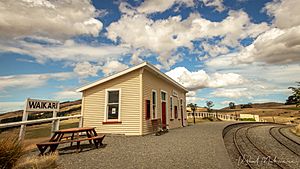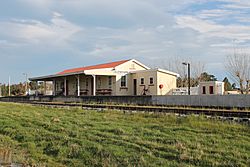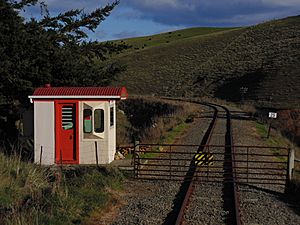Weka Pass Railway facts for kids
Quick facts for kids Weka Pass Railway |
|
|---|---|

A 428 just leaving Frog Rock cutting.
|
|
| Locale | Waipara, |
| Terminus | Glenmark Station and Waikari Station |
| Coordinates | 43°03′16″S 172°45′28″E / 43.0544°S 172.7579°E |
| Connections | KiwiRail Main North Line |
| Commercial operations | |
| Name | Waiau Branchline |
| Built by | New Zealand Government Railways |
| Original gauge | 1,067 mm (3 ft 6 in) |
| Preserved operations | |
| Owned by | Weka Pass Railway Society |
| Operated by | Weka Pass Railway Society |
| Stations | Two |
| Length | 12.8 km (8.0 mi) |
| Preserved gauge | 1,067 mm (3 ft 6 in) |
| Commercial history | |
| Opened | 15 December 1919 |
| Closed | 15 January 1978 |
| Preservation history | |
| 1982 | Formation of Society |
| 1984 | First Operation of Trains |
| 1993 | Recommissioning of A 428 |
| 1995 | Inaugural Waipara Vintage Festival |
| 1999 | Official opening of the railway |
| 2003 | Opening of the Waikari turntable |
| 2009 | Opening of the Glenmark turntable |
The Weka Pass Railway is a special heritage railway in Waipara, North Canterbury, New Zealand. It runs on a 12.8 km (about 8 miles) section of an old railway line called the Waiau Branch. This line goes between Waipara and Waikari. The railway is run by a group of volunteers who love trains. Most of them live in Christchurch, which is about 60 km (37 miles) south. The Weka Pass Railway started carrying passengers in 1984. It is now a popular attraction for both locals and visitors.
Contents
Discover the Weka Pass Railway's Journey
How the Railway Began
The railway line through the beautiful Weka Pass to Waikari was finished in 1882. This area is famous for its amazing views. The railway goes through big cuttings, around tight curves, and up steep hills. When it was first built, people thought this line would be part of the main railway going north from Christchurch.
More sections of the line were built over the years. The line officially opened to Culverden in 1886. The very last part to Waiau was not ready until 1919. In the 1920s, a decision was made to build the main railway line along the coast instead. This coastal line, which needed a lot of difficult construction, was not finished until 1945.
Over time, fewer goods were carried on the Waiau Branch line. This was because more people started using roads for transport. Many rural railway lines closed down because of this. The Waiau Branch had a short busy period when it carried many logs from the Balmoral forest. But it finally closed on 15 January 1978.
Starting the Heritage Railway
In August 1982, a public meeting was held in Waipara. People wanted to save a part of this old, scenic railway line. Local people in Waipara saw that it could be a great tourist attraction. Railway fans, many from the Ferrymead Railway, also helped. The Weka Pass Railway Society was officially formed in November 1982.
The new group started talking with NZ Railways to buy the track, trains, and other equipment. In May 1983, they held their first big public event. It was called the "Mayfair Festival." People rode in old wagons pulled by steam engines.
In July 1983, the railway agreed to lease the line. Public train rides started on 4 June 1984. The WPR bought the leased section of the line in September 1984. Train rides stopped for a short time due to legal issues. But they started again on 17 March 1985.
After the original line closed, most of the track stayed in place. However, a road crossing in Waikari was removed. Because of this, the WPR decided to remove the track between Waikari and the Hurunui River. This section was lifted by July 1991.
Railway Tracks and Turnstiles
The Railway Track
The Weka Pass Railway uses 12.8 km of the old Waiau Branch line. It runs between Waipara and Waikari.
In 1986, heavy rain caused damage to the line. The railway needed a lot of repairs. By April 1987, trains could run again for about 5.5 km. More repairs were needed in September 1987. Trains started running again on 28 January 1988. Around this time, parts of the track near Glenmark Station were also fixed.
On 3 June 1990, trains started going further. By September 1999, the line was officially open all the way to Waikari. This was a very important day for the WPR. Special trains ran to celebrate. In 2001, a new track switch was added in the Waipara yard.
Turning Trains Around: Turntables
The railway has special spinning platforms called turntables at both Glenmark and Waikari. A 55-foot turntable was put in Waikari in October 2002. It started working on 31 August 2003. This turntable was found in a scrap heap in Christchurch.
A bigger 62-foot turntable was installed at Glenmark (Waipara). It took 14 months to fix and install. It reopened on 12 July 2009. These turntables allow the locomotives to be turned around. This means they can always face the right way for the journey. In 2010, the railway won an award for restoring these two turntables.
Buildings Along the Line
Train Stations
Glenmark Station
The building for Glenmark Station was originally the Mina Railway Station. It was built in 1910. It served many trains on the Main North Line. In 1980, the station closed.
A family from Cheviot raised money to save the station. They moved it to Waipara in 1987. The building was moved in two parts. A new roof and foundations were built. A covered porch was also added. The station has been in use since April 1988. It was renamed Glenmark Station to avoid confusion with the Waipara Station.
Waikari Station
The Waikari Station building was originally the Hundalee Station. It was built in 1939. This station also served trains on the Main North Line. The WPR bought the building. It was moved to Waikari on 29 October 1991. By July 1992, it was fully restored. It served its first train in Waikari on 11 September 1999.
In 1995, the railway received an award for restoring these two stations.
Locomotive Workshop
In the mid-1980s, a workshop was built in the old Waipara rail yard. This is where the trains are repaired. It was made bigger in 2005.
Carriage Shed
A shed for the railway carriages was built between 2005 and 2006. It keeps the carriages safe and dry. It also stores the track inspection car and some diesel locomotives. In 2012, new doors were added to the shed.
Gate Huts
The railway runs through private farmland. So, people called Gate Keepers are needed at Gates No. 1 and 2. They make sure farm animals do not get onto the tracks. Small huts were built for them. Later, bigger huts were brought in. In 2004, two new huts were built. They were named after two members who had passed away.
How the Railway Works: Volunteers and Jobs
The Weka Pass Railway is run completely by volunteers. These volunteers come from all different backgrounds. They have many different interests in the railway. Some help with track work during the week. Most of the work happens on Saturdays. This includes moving trains around and doing repairs. The railway offers free training for volunteers.
On days when trains are running, here are some of the important jobs:
Train Control Officer (TCO)
The TCO makes sure trains run safely on the single track. They give permission for trains to move. They talk to the train drivers, gate keepers, and the Waikari stationmaster.
Waikari Stationmaster
The Waikari Stationmaster drives a small vehicle to check the track each morning. At Waikari, they sell tickets to passengers. They also help trains enter the station and move around. At the end of the day, they drive the track inspection vehicle back.
Guard
The Guard is in charge of the train. They check the brakes and collect tickets from passengers. They also help manage crowds during photo stops. They can talk to passengers and share information about the views. Most importantly, they make sure the train runs safely.
Assistant Guard(s)
Assistant Guards help the Guard with their duties. They might collect tickets or count passengers.
Locomotive Driver
The Driver gets the locomotive ready and drives it. They are responsible for operating the train. The line has steep hills, so they must be careful to prevent the wheels from slipping. They also need to make sure there is enough water in the boiler for steam engines. They must brake carefully when going downhill.
Locomotive Assistant/Fireman
The Fireman helps the driver. For steam locomotives, the fireman adds coal to the fire to make enough steam. They also make sure there is enough water in the boiler. For diesel locomotives, the assistant helps the driver and watches the track ahead. As they get more experience, they learn how to drive the locomotive.
Locomotive Trainee
Trainees ride in the cab with the crew. They practice firing techniques on steam engines. Experienced crew members teach them and give advice. Trainees also learn how to prepare parts of the locomotive.
PPA (Preparing and Putting Away) Assistant
When it's very busy, PPA assistants help the crew. They have similar skills to trainees. They help get duties done faster. This helps the crew finish their shifts on time.
Gate Keeper
The railway crosses private farmland. Gate Keepers make sure farm animals do not cross the tracks. They tell train control if animals are blocking a gate.
Trains and Rolling Stock
The railway owns four locomotives. All of them used to belong to the New Zealand Government Railways. They also have many old New Zealand Railways carriages and wagons.
Steam Locomotives
| Key: | Running | Being repaired | Stored | On display |
|---|
| Original name and number | Builder | Year built | Year arrived | Notes |
|---|---|---|---|---|
| A 428 | A & G Price | 1909 | 1983 | This locomotive was bought by a special group in 1973. It has been used by the WPR since 1983. It was fully restored in 1993 and has been running ever since. It is now owned by the WPR. |
Diesel Locomotives
| Key: | Running | Being repaired | Stored | On display |
|---|
| Original name and number | Builder | Year built | Year arrived | Notes |
|---|---|---|---|---|
| DE 512 | English Electric | 1951 | 2015 | This locomotive is on loan to the WPR. It is used for work trains and moving wagons around. |
| DG 770 | English Electric | 1955 | 1983 | The WPR bought this locomotive in 1983. It is used for passenger trains. |
| DG 791 | English Electric | 1955 | 1983 | The WPR bought this locomotive in 1983. It is also used for passenger trains. |
| DSA 276 | Mitsubishi Heavy Industries | 1967 | 1992 | This locomotive is currently being repaired. |
Carriages (Passenger Cars)
| Key: | Running | Being repaired | Stored | On display |
|---|
| Original name and number | Builder | Type | Year built | Year arrived | Notes |
|---|---|---|---|---|---|
| A 523 | NZR Addington Workshops | Wooden passenger carriage | 1896 | 1986 | This is the oldest piece of rolling stock the railway owns. It is used as a bunkhouse for volunteers. |
| A 1720 | NZR Addington Workshops | Steel-panelled mainline coach | 1931 | 2020 | Purchased in 2019. |
| A 1730 | NZR Addington Workshops | Steel-panelled suburban carriage | 1931 | 1983 | Used for suburban services in Dunedin. It was repaired from 2012 to 2018. |
| A 1731 | NZR Addington Workshops | Steel-panelled mainline coach | 1931 | 1983 | Also used for suburban services in Dunedin. It was repaired from 2004 to 2011. It won an award in 2012 for its restoration. |
| A 1732 | NZR Addington Workshops | Steel-panelled suburban carriage | 1931 | 2009 | Stored, waiting to be restored. |
| A 1733 | NZR Addington Workshops | Steel-panelled suburban carriage | 1931 | 1983 | Currently being repaired. |
| A 1760 | NZR Addington Workshops | Steel-panelled suburban carriage | 1932 | 2008 | Stored, waiting to be restored. |
| AL 1697 | NZR Addington Workshops | Steel-panelled suburban carriage | 1930 | 1983 | Rebuilt as a car-van in 1969. Restored from 1990 to 1993. |
| A 1935 | NZR Addington Workshops | Steel-panelled mainline carriage | 1939 | 2001 | Currently in storage. |
Viewing Cars
| Key: | Running | Being repaired | Stored | On display |
|---|
| Original name and number | Builder | Type | Year built | Year arrived | Notes |
|---|---|---|---|---|---|
| T 155 | NZR Addington Workshops | Wooden covered viewing car | c1960 | 1981 | This used to be a cattle wagon. It was changed into a covered viewing car in 1988. |
| T 157 | NZR Addington Workshops | Wooden open viewing car | c1960 | 1984 | This also used to be a cattle wagon. It was changed into an open viewing car in 1993. |
Vans (Brake Vans)
| Key: | Running | Being repaired | Stored | On display |
|---|
| Original name and number | Builder | Type | Year built | Year arrived | Notes |
|---|---|---|---|---|---|
| F 497 | NZR Hillside Workshops | Wooden body brake van | 1927 | 1985 | Donated by a member. It was restored from 1997 to 1998. |
| F 699 | NZR Addington Workshops | Wooden body brake van | 1964 | 1987 | This is one of the last wooden vans built by the NZR. It was restored in 1994. |
Wagons (Freight Cars)
| Key: | Running | Being repaired | Stored | On display |
|---|
| Original name and number | Type | Builder | Year built | Year arrived | Notes |
|---|---|---|---|---|---|
| E 2882 | Open high sided wagon | NZR Hillside Workshops | 1908 | 1983 | Stored, waiting to be restored. |
| EA 1664 | Covered wooden bogie wagon | NZR Addington Workshops | 1935 | 1987 | Used to carry the track work crew. |
| EUB 4164 | Bogie crane support wagon | NZR Addington Workshops | 1926 | 1989 | Used to support the diesel crane. |
| H 1557 | Cattle wagon | Hurst Nelson (assembled at Addington Workshops) | 1959 | 1981 | Restored in 1998. |
| JC 4971 | Sheep wagon | NZR Addington Workshops | c1952 | 1989 | Restored in 1999. |
| Unidentified KP | Box Wagon | Mitsubishi Heavy Industries | N/A | 1991 | Used as a storage shed without wheels. |
| KS 4556 | Steel covered wagon | NZR Addington Workshops | 1970 | 2000 | Owned by the Rail Heritage Trust. |
| KS 4479 | Curtain sided wagon | NZR Otahuhu Workshops | 1970 | 2000 | Owned by the Rail Heritage Trust. |
| LA 20341 | Open high-sider | NZR Otahuhu Workshops | 1941 | c1995 | Stored, waiting to be restored. |
| LA 21338 | Open high-sider | NZR Addington Workshops | c1950 | 1986 | |
| LC 25542 | Steel open high side wagon | NZR Otahuhu Workshops | 1950 | 1990 | |
| LPA 1193 | Steel high side paper wagon | Mitsubishi Heavy Industries (assembled at Otahuhu Workshops) | 1973 | 2001 | Owned by the Rail Heritage Trust. |
| MC 2386 | Wooden open low side wagon | NZR Addington Workshops | 1959 | 1987 | Repaired in 1999 and 2018. |
| Steel flat-top wagon | NZR Hillside Workshops | 1985 | 2000 | Owned by the Rail Heritage Trust. | |
| T 168 | Bogie cattle wagon | NZR Hillside Workshops | 1960 | 1984 | Stored, waiting to be restored. |
| UB 618 | Bogie steel flat deck wagon | NZR Newmarket Workshops | 1908 | 1983 | This is the oldest freight wagon the railway owns. |
| UC 860 | Bogie tank wagon | NZR Addington Workshops | 1930 | 2000 | Owned by the Rail Heritage Trust. Stored, waiting to be restored. |
| UC 1232 | Bogie tank wagon | NZR Addington Workshops | 1947 | 2001 | Owned by the Rail Heritage Trust. |
| UD 1504 | Bogie Works and Way Well wagon | NZR Otahuhu Workshops | 1952 | 2000 | Owned by the Rail Heritage Trust. Used on KiwiRail work trains if needed. |
| UR 2275 | Steel flat deck bogie log wagon | NZR Addington Workshops | 1965 | 1989 | Used on work trains. |
| VR 137 | Bogie Steel Insulated wagon | Kinki Sharyo Co. (assembled at Otahuhu Workshops) | 1964 | 1983 | |
| XP 3226 | Ventilated Box Wagon | NZR East Town Workshops | 1967 | 1983 | Restored in 1999. |
| YB 578 | Ballast wagon | NZR Hillside Workshops | 1942 | N/A | |
| YB 621 | Ballast wagon | NZR Hillside Workshops | 1942 | N/A | |
| YB 634 | Ballast wagon | NZR Hillside Workshops | 1942 | N/A | |
| YB 637 | Ballast wagon | NZR Hillside Workshops | 1942 | N/A | |
| YC 838 | Central-discharging ballast wagon | NZR Addington Workshops | 1960 | 2007 | Owned by the Rail Heritage Trust. |
| YC 856 | Central-discharging ballast wagon | NZR Addington Workshops | 1960 | 2007 | Owned by the Rail Heritage Trust. Sometimes used on work trains. |
| YD 1035 | Bogie side-dump wagon | Differential Car Company | c1950 | 2013 | Sometimes used on work trains. |
| YF 909 | Side discharge ballast wagon | NZR Addington Workshops | 1964 | 2007 | Sometimes used on work trains. |
| YF 916 | Side discharge ballast wagon | NZR Addington Workshops | 1965 | 2001 | Owned by the Rail Heritage Trust. |
| Z 356 | Covered wooden bogie wagon | NZR Otahuhu Workshops | 1946 | 1989 | Being restored. |
Cranes
| Key: | Running | Being repaired | Stored |
|---|
| Number | Type | Lifting capacity | Builder | Year built | Year arrived | Notes |
|---|---|---|---|---|---|---|
| 197 | Diesel | 10 Tonnes | Ransomes & Rapier | 1943 | 1989 | This was NZR's first diesel crane. It was repainted in 2016. |
| 305 | Coaling | 500 Kilograms | N/A | 1925 | N/A | Used to load coal onto steam engines. It is currently stored and waiting for repairs. |
Track Inspection Cars
| Key: | Running | Being repaired | Stored |
|---|
| Class | Number | Builder | Year built | Year arrived | Notes |
|---|---|---|---|---|---|
| WW | 5139 | Wickham Of Ware | 1950 | 1984 | This small car is used to check the railway tracks. It was sold to the WPR in 1984 and restored in 1985. Its engine was replaced in 2002. |
Images for kids











